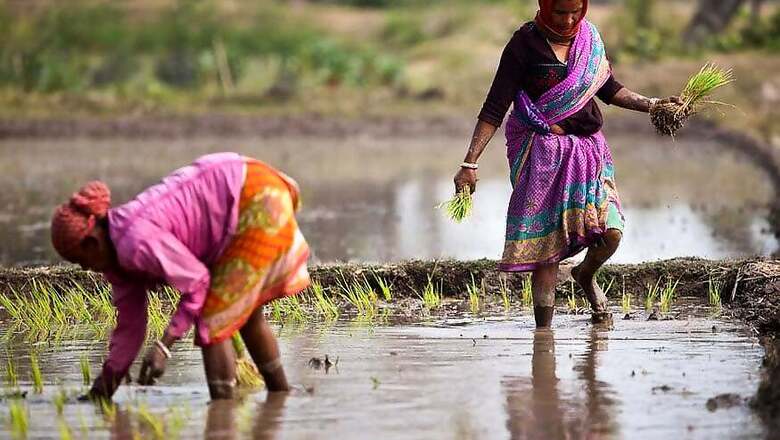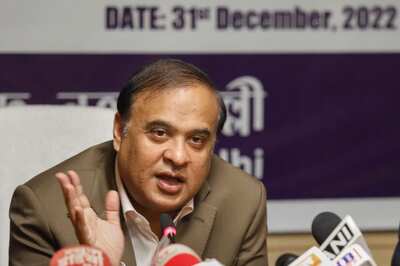
views
In the Beed district of Maharashtra, several women have no wombs. According to a report published in The Hindu BusinessLine, these women, who work as cane cutters, voluntarily undergo hysterectomies, a surgical operation to remove the uterus.
In search of livelihood, these women migrate every year from the drought-prone Marathwada region to the sugarcane farms of western Maharashtra. Fearing that farm contractors won't hire them if they ask for off days during their menstrual cycle, these women take the extreme step of removing their uterus.
While this may be a terrifying example of how climate change affects the lives of Indian women, this isn't the only one.
It has already been proven that climate change doesn't impact men and women equally. According to a United Nations report on women and climate change, "Women are more vulnerable to the effects of climate change than men — primarily as they constitute the majority of the world's poor and are more dependent for their livelihood on natural resources that are threatened by climate change."
In India, however, the gender disparities vis-a-vis climate change are more pronounced. Women not only face negative physical and psychological health issues due to climate change, but are also the worst affected during agrarian crisis and natural disasters.
While trends suggest that it is mostly women from poor and rural cross-sections who are the worst affected, even urban women from middle-class backgrounds aren't immune to climate change, as migration patterns reveal.
How Climate change Impacts Women's Livelihoods
In the last 10 years, India has seen unprecedented migration. According to the Economic Survey of India 2017, inter-state migration has been estimated at nine million annually between the years 2011 and 2016. Most male agricultural labourers who lived in rural areas moved to cities to find work, leaving behind women to do farming, which means that during any agrarian crisis, women will be most affected.
"Eighty per cent of farmers are now women. This, in theory, is what we call feminisation of agriculture," said Nishtha Satyam, deputy representative, UN Women Office for India, Bhutan, Maldives and Sri Lanka. "Whenever the agrarian crisis escalates, we realise that those who are disproportionately impacted by it are women. That puts women at the centre of climate change," she added.
Satyam pointed out that trafficking of women and girls, their forced migration and lack of equal opportunities at work are all factors which can be closely linked to climate change.
UN Women has been working on various ways to empower women to face climate change. "One of the biggest policy gaps that we have experienced is that government does not recognise the identity of a woman as a farmer," she said.
One way to prepare women for environmental changes is to teach them climate resilient agriculture. "We teach them crop rotation, help them identify mitigation mechanisms related to climate change, and diversify irrigation methods. We also plan to work on training women so that they become both active consumers and producers of the decentralised renewable methods of energy, which will not only provide them with a livelihood but also help in mitigating climate change," Satyam said.
Women in India are often undercut by discriminatory societal norms which implicitly prescribe that landowners must always be men. Another problem is that since the government does not identify women as farmers, the benefits that various states and the central government offer to agricultural landowners and farmers do not trickle down to them.
Shaikh said Swayam Shiksha Prayog advocates in favour of making women farmers landowners. When women become decision-makers and stakeholders in the agriculture sector, they will definitely be better equipped and empowered to face climate change, she pointed out.
Impact on Women's Health
Malnutrition and food insecurity caused by climate change affects the health of Indian women severely. "Anaemia is sometimes caused by malnutrition," pointed out Cecilia Sorensen, an Emergency Medicine Physician at the University of Colorado and currently a Living Closer Foundation Fellow in Climate and Health Policy.
"If there is food insecurity because of drought or any other kind of environmental change, it will be reflected in anaemia. It is also generally found that women who occupy lower socio-economic status tend to have higher rates of anaemia," added Sorensen.
Sorensen is one of the authors of the review article published in the American Geophysical Union (AGU) journal, titled ‘Climate Change and Women's Health: Impacts and Opportunities in India’. The article states that women are inherently sensitive to food insecurity which results in nutrient, especially micronutrient deficiency which further causes cognitive impairment, cause poor attention span, diminish working memory and also impair sensory perceptions.
The article also points out that, "as a result of alterations in temperature and precipitation, the geographic range and abundance of disease vectors is changing, exposing more people to tick-borne, and mosquito-borne illnesses."
"Pregnant women are especially vulnerable to such illnesses," noted Sorensen. "During pregnancy, women undergo several biological changes and their immune systems are compromised. As a result, a higher intensity of malaria-causing parasites is found in their bloodstreams. Apart from that, pregnant women also tend to breathe faster and more often. Mosquitoes use exhaled respiratory air to locate humans. So, pregnant women become an easy target," she added. Not only that, it is said that rising seasonal temperatures and extreme heat events like droughts are likely to adversely impact the reproductive outcomes too, causing gestational hypertension and preeclampsia.
Water scarcity resulting due to climate change also impacts women's health. In India, it is generally a woman's job to get water for the household. As groundwater disappears from several areas of India, women have to travel longer distances, often in the scorching heat, to access water and it results in extreme fatigue in them. In the absence of clean water sources, often, the water that they drink or use is contaminated or has toxins. While exposure to such water sources increases the scope of waterborne infections, drinking it has its own health hazards.
Women and Air pollution
Apart from climate change, another environmental condition that impacts Indian women is air pollution. Biomass is one of the main reasons for the air pollution that women are generally exposed to. It is often used in cooking and heating in Indian households, exposing women to its harmful effects.
"While looking at the climate vulnerability, an important thing is to understand that different sets of people have different vulnerabilities," said Sorensen.
"Men and women have different exposures when it comes to air pollution. While men breathe in a lot of ambient pollution on the streets, women are not only exposed to that but also to the harmful biomass, as they spend most of their days cooking in closed spaces where air cannot circulate," she added.
She also noted that women are generally more anaemic than men and have lower RBC (red blood cells) counts, and what is worse is that certain toxins in air pollution are said to be detrimental to the RBCs. Reports also claim that women are vulnerable to the deposition of used particles in their lung tissues.
Disasters caused by climate change make women vulnerable to death, sexual abuse and employment loss.
While disasters seldom discriminate, how people react to such calamities and behave during them vary. "One impact of climate change is the increased frequency of extreme events like droughts and floods. During such calamities, women and children are most vulnerable because they are not as mobile as the male population," pointed out Sambuddha Misra, assistant professor at the Centre for Earth Sciences, Indian Institute of Science, Bangalore.
It is a global trend that more women are affected by disasters caused by climate change as compared to men. In fact, according to a 2004 World Health Organisation report, it is women who are more likely to die during floods and cyclones. Resource shortage due to disasters also impacts women more intensely because they are naturally more calorie-deficient than men which, in turn, reduces their chances of survival.
Unfortunately, there are very few gender-related studies of disasters done in India, which makes it difficult to measure the unique problems Indian women face during such calamities. However, it won't be a stretch to say that Indian Women, 84 per cent of whom have 'vulnerable employment', are badly affected during such occurrences. While many lose their jobs and homes, there are several others-- especially young girls -- who become susceptible to sexual violence and abuse at the aftermath of any disaster. Disabled and elderly women from lower economic groups are also vulnerable during such calamities as they do not have a support system.
Catastrophes, violence or sexual abuse faced during such times may have a long-term impact on the women's psychology too, pushing them towards post-traumatic stress or depression. "The government shelters should ensure that there are no safety issues for women during floods," added Misra.
The professor pointed out that before floods happen or cyclones hit, it is prudent to have a 'strategic preparation' as Odisha did during cyclone Feni. Similarly, for areas prone to extreme droughts, precautionary measures can prove helpful.
"It is always a good idea to go back to traditional ways of water conservation along with recent technological advancement. Instead of being completely dependent on government water supplies, local scale water recycling can help a lot during such times," noted the professor.
Talking about a gendered approach to disasters, Chandrashekhar Singh, a senior researcher at the Department of Climate Change, Integrated Research and Action for Development, said, "We have to design our climate change mitigation strategy in such a way that we do not overlook women's needs."
"Whenever extreme climatic changes happen, our first job should be to think about the basic need of men and women separately and then try to cater to them. For example, during floods, it is hard for women to meet their sanitation needs as compared to men. So, disaster management planning should work at providing proper sanitation to women during such calamities," he added.
Public warnings of disasters should also be made more accessible to women who are illiterate and/or do not understand popular languages.
It is high time climate change is viewed through the gender lens and more endeavours are made to collect data that explains how this phenomenon impact women. The government, too, not only needs to frame more policies to mitigate climate change, but also take into account its impact on women.




















Comments
0 comment